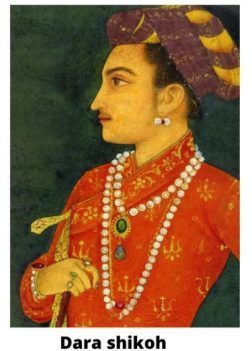What if Dara Shikoh became the Mughal Emperor instead of Aurangzeb?
Social and Religious scenario of Dara Shikoh
Dara Shikoh was the son of Shah Jahan and brother of Aurangzeb. He was made a military commander at an early age and was later made the governor of Kabul and Multan. In the present understanding, he is well known for his intellectual pursuits. He was a philosopher, intellectual, and poet. He was encouraging the philosophy of the Upanishads and translated them along with Bhagavad Gita to Persian. He learned from Hindu Pandits and Christian priests. An ardent follower of Sufism, he also developed friendships with the Sikh Guru, Guru Har Rai. His well-known book Majma-ul-Bahrain which meant confluence of seas was a comparative study of Vedanta and Sufism. He was deeply syncretic, warm-hearted, and generous.
However his intellectual achievements, Dara was not a successful military man or could not have become an able administrator which was clearly reflected in the war of succession (Dara had the support of the Emperor, nobles, and army). Subsequently, his persona was in contrast to that of Aurangzeb who is usually described as orthodox and rigid but an effective military commander. If one has to speculate on the situation in the subcontinent if Dara had come to power, on the outset it could be concluded that the much-debated religious policies of Aurangzeb would not have been a cause of concern.
Aurangzeb’s attempt to reassert the Islamic character of the state by the emphasis of Sharia, re-imposition of Jizya, destruction of newly built temples or also old temples at Mathura and Varanasi, to punish rebellions, his clash with the distinguished Sikh leader, banning of music, etc. projected Aurangzeb in contrast to his predecessors. Maybe, this would not have been the case under Dara Shikoh who was well known for his liberal outlook.
Philosophy, Religion, and Political scenario
Encouragement towards the study of philosophy and religion would have been initiated. Further, it is important to understand the various problems that Aurangzeb faced and how he dealt with them. The problem with Rajputs, Jats, Sikhs, and Afghans was not new and was faced by Aurangzeb’s predecessors too. The forces of disintegration present in the Empire from the beginning which were brought under control by Akbar intensified during Aurangzeb. Aurangzeb’s policy towards Mewar and Marwar weakened the Mughal alliance with Rajputs at a crucial time. The problem with the Sikhs ended up accentuating the issue.
The conflict with the Ahoms in Assam showed the limits of Mughal power in far-flung regions. The execution of Sambhaji in 1689CE further strengthened the cause of Marathas. After his death in 1707, Aurangzeb left behind a state where the internal problems had reached their peak. Historians have argued that Aurangzeb lacked the foresight to check the forces. It is difficult to argue on how could have Dara dealt with the conflicts. He definitely did not possess the rigidity of Aurangzeb and perhaps could have pursued policies of reconciliation.
Meanwhile, It was under Aurangzeb’s hand that the Mughal empire reached its territorial peak, and administration of such would have required an able bureaucrat. Keeping aside any of Aurangzeb’s failures, if Dara Shikoh had graced the throne, it can be argued that he would have proved to be an ineffectual administrator in comparison to Aurangzeb. To conclude, an important aspect surrounding Aurangzeb was the decline that set in the Empire after his death. The decline of the Empire and Aurangzeb’s responsibility for it is again hotly contested debates. William Irvin and Jadunath Sarkar have argued that the religious policies of Aurangzeb provoked a reaction that was detrimental to the empire.
Satish Chandra opined that the Jagirdari crisis, with the inability of the Mughal Jagirdars to resist the assertiveness of Zamindars and to protect the peasantry, led to the decline. M N Pearson blames the Deccan Campaign and the Marathas to have caused a serious setback eventually leading to a decline of the Empire. J F Richards has argued that the mismanagement of Jagirs by Aurangzeb led to the crisis. Karen Leonard suggested that there were Great Firms that played an important role in determining the fortunes of the Mughal Empire in the seventeenth and first half of the eighteenth centuries.
As above all financial systems shifted from Mughal to post -Mughal states, the imperial decline set in. M Athar Ali holds cultural failure underlying the root cause of technological stagnation. If Europe was burgeoning with scientific advances, the Islamic Empires were deteriorating. Irfan Habib pointed out that the Empire had been struck by an agrarian crisis by the mid-seventeenth century. The periodical transfer of Jagirs, exploitation of the peasants resulted in an armed rebellion of peasants. consequently, if we look at the broad trends of the historiography of the Imperial decline, there are several factors that contributed to it.
The circumstance of the discussion, Dara Shikoh as an Emperor could not have inflicted a dramatic change on the Empire. Owing to the idea that Dara would have been a weak military leader and administrator, the regional forces could have nonetheless asserted themselves. The frequent wars of succession or the economic crisis could have led to a decline in the same way.
In conclusion, these are what is phrased as the ‘ifs and buts of history’, there could have been numerous possibilities on the courses and outcomes of events which only History can inform. Also viewing historical developments based on specific individuals will only lead to a limited understanding.
References:
Chandra, S. (2014). History of Medieval India (pp. 332-378). New Delhi: Orient Blackswan.
Rana, R. (2006). Was there an Agrarian Crisis in Mughal North India during the Late Seventeenth and Early Eighteenth centuries?. Social Scientist, 34(11), 20-22.





